Don't wanna be here? Send us removal request.
Text
Week 14: I Walked Out of Mr. Bialak’s Class for the Last Time
It still feels like yesterday — that very first class, walking in not knowing what to expect. I can still vividly remember it, just like I remember all the moments when he was extra moody back in Year 1 and Year 2. I'm really glad I got to go through all my pieces one last time with him, both in this final class and the one before. Today, we worked on Suite Bergamasque and Philip Glass’s Etude No. 2. It felt like everything came full circle — familiar pieces, a familiar classroom, and a teacher who’s been there through it all. It has been decided that I will be using my score for the full recital, as both Mr. Allan and Mr. Bialak agreed that I play more musically with the score in front of me. I used to feel a bit unsure about not playing from memory, but knowing that it helps me focus more on the music itself has made me feel more confident in this decision. I’ve realized that in the past, I wasn’t able to present my music to its fullest because I was always stressed about my memorization. Even when playing from memory, I couldn’t fully immerse myself in the music. Having the score now feels like a shift. I’m able to focus more on the music itself and really connect with it, instead of being distracted by the pressure to remember every detail.
While today’s playing went relatively well, I still need to tidy up my timing, note accuracy, and touch. I actually think I’m going to take a break from the pieces before working on them again. Over the years, I’ve learned that I tend to get tired of pieces if I keep working on them without a break. My muscle memory starts to take over, and things end up feeling rushed or messy. Even with the score in front of me, I’ve noticed there can be lapses in memory, which only adds to the frustration. Taking a step back will give me the chance to come back to the pieces with fresh ears and a clearer mind.
Conclusion
As I move forward with this recital, I’m starting to realize that the journey through these pieces is just as important as the final performance. Every class, every practice session, and every adjustment along the way has shaped not only how I approach the music but also how I connect with it on a deeper level. I’m grateful for the opportunity to have worked with such supportive teachers who understand my process as a musician and have guided me toward finding my own path. Their insight has given me the confidence to trust myself and the music, and that’s something I’ll carry with me long after this recital is over.
0 notes
Text
Week 13: The ‘Not Quite Goodbye’ Class
Today was the second last PS class. It’s starting to feel real, and honestly, I’m not ready for it.
I shared Dream in Exile, Goyescas No. 4, and the Prelude from Suite Bergamasque today. Each one holds a different part of me. Fragments of what I’ve learned, struggled with, and grown into.
It’s crazy how music can reflect so much. One moment you’re just playing, and the next you’re realising how much you’ve grown. One more class to go. Not sure how I feel yet. I know I’ll miss this, and honestly, I don’t feel ready to be on my own until the final recital. There was a lot of improvement in my pieces today. I realised I hadn’t really been listening to myself for the past few weeks. I think I was getting a bit tired of the music—just going through the motions, playing it every day without really being present. So on Friday, I decided to record myself and actually listened back—and that’s when things clicked. I finally understood what Mr Bialak had been trying to tell me in his feedback. I also compared my playing to a few recordings on YouTube, and that helped a lot. I ended up making some changes, and it really made a difference. In general, I think my phrasing could be more pronounced, so there’s a clearer sense of direction in the music. I also have a tendency to rush through things, which makes the playing feel a bit rash. That takes away from the more relaxed, lyrical character the music is supposed to have. Note accuracy is another area I need to work on—just making sure every note, especially in the melody, comes through clearly and cleanly. Goyesca No.4 Bar 5-6: Wait a little before entering bar 6, start slow then speed up a little

Bar 21: Don't rush LH semiquavers

Bar 28-29: Do not rush LH appoggiaturas

Bar 38: Keep RH non-melodic notes soft (highlighted in grey)

Bar 62: Tiny diminuendo for RH

Bar 68-end: Keep everything soft and light

Prelude- Suite Bergamasque Bar 20: Slowly enter, do not rush Make sure to play every note clearly.
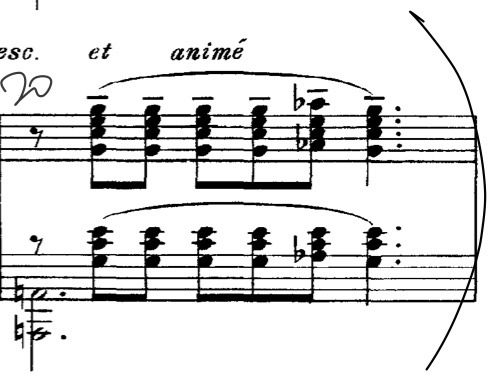
Dream in Exile Rhythm accuracy has improved. Bar 3: LH demisemiquavers to be more delayed. Bar 4: Rubato RH from "G" onwards, not too early and strong

Bar 45-53: Not too slow or else it would sound hesitant

Bar 69: Larger swell as compared to previous bar, or it will sound flat Bar 71: RH enters immediately after LH

Conclusion
With just one class left, there's still work to do before the final recital, but looking back, I can see how much I’ve improved. It’s all about staying present, listening to myself, and making those small adjustments that add up. On to the next one—let’s see what I can make of it in the final stretch.
0 notes
Text
Week 12: Déjà Vu at the Piano, Another Run-Through
Second run-through, third-to-last personal study. The semester always seems to speed up after project week. With just a few more study sessions left, everything’s starting to feel real.
Today, we went over the order of my pieces. It’s a small thing, but it makes such a difference in how the whole performance comes together. I’m trying to be strategic about the order of my program since it doesn’t necessarily need to follow a chronological sequence. I plan to organize my program in a way that allows me to maintain focus and avoid freezing my fingers from playing too long in the air-conditioned room. I tried it out in this order:
1. Poulenc - Nocturne No. 1
2. Debussy - Suite Bergamasque
3. Granados - Goyesca No. 4
4. Glass - Etude No. 2
5. Bax - Dream in Exile
After running through the program, I found that I had difficulty shifting my mood and focus into Goyesca after Clair de Lune. The transition felt a bit challenging, as the emotional tone of the pieces is quite different, and I struggled to find the right mindset for Goyesca after the introspective nature of Clair de Lune. I’ll probably need to switch up the order of the pieces to make the transition smoother.
Conclusion
Overall, the feedback was that my attention tends to wander during the performance. My shaping isn’t as clear and expressive as it should be for the audience, and I struggle to sustain both focus and emotional depth throughout the piece. Additionally, the pulse seems a little unstable at times. It looks like I’ll need more practice with the metronome to stabilize the pulse, and recording myself to listen from a third-person perspective should help me identify areas that need improvement.
0 notes
Text
Week 11: A conversation about my memory and a full run-through
Mr. Bialak and I discussed the idea of using the score and the challenges I faced with memorization. It seems like he now expects zero slips since I’ll have the music infront of me.
I told Mr. Bialak that playing from memory felt like a hindrance because I’m constantly worried about whether I’m remembering the music correctly. There also seem to be random memory slips that only appear when I perform for an audience—ones that never happen during my own practice. If I were to rank the quality of my playing, the best would be with the score, followed by playing from memory in my own private space, and the worst would be playing from memory in front of an audience.
He suggested that it would be ideal to perform some pieces from memory and others with the score, but I find playing from memory quite risky. Additionally, there will be the added pressure of performing in an unfamiliar, large space in front of an audience on the actual day.
Memory talk aside, i did my first program run through today. While there wasn’t any bar or note-specific feedback, the general suggestion was that I should take longer breaks between pieces to allow the listeners to process each one and cool down (myself included) before moving on to the next. Instead of feeling like I’m running a marathon, hastily rushing into the next piece just to get through the entire program. My attention also tends to wander at the beginning of each piece before I recollect myself. Maybe that has to do with not resting enough between pieces.
This pretty much sums up today’s lesson. Mr. Bialak will have a meeting with the other adjudicators regarding the use of the score for my entire program and get back to me.
0 notes
Text
Week 10: The Speeding Ticket I Wish I Could Give My Fingers
Today, we continued working on Dream in Exile and also played Goyesca. It seems my biggest challenge today was my hysterial tendency to speed up and then suddenly slow down. Apparently, my Dream in Exile today wasn’t as great as last week’s… and I think I know why. I had been practicing on my own, listening to recordings, and mimicking them. But why is it that when the recordings speed up, it sounds natural, yet when I do it, it feels completely off? Maybe I should just stick to playing more conservatively—nothing too crazy. Dream in Exile
Metronome practice is definitely needed—it's been a while since I really focused on keeping my rhythm tight. According to Mr. Bialak, my timing and rhythm have been off throughout the entire piece. Today, the piece sounded more unsettling than calming… maybe I had a little too much coffee. Mr Bialak suggested revisiting the piece after i checked my rhythm. Goyesca No. 4
Goyesca had the same issue with abrupt speed-ups, even though it has its own beautiful moments. I just need to let the music flow more naturally. Bar 1-2: Make sure to bring out the melodic line with a strong, clear sound, Cresc. towards first beat of bar 2 Bar 5: Keep acciaccatura "A" really soft Bar 9: Speeding up way too much, need to make it fit into the flow of the music Bar 11: LH triplets should be faster

Bar 18: Make sure to play ornaments in both hand clearly Bar 21: Make sure right hand hemidemisemiquavers sound clear
Bar 23: Pick one melodic line to voice (ive chosen the one highlighted in pink)

Bar 29: Speeding up too much
Bar 35-36: Improve on accuracy of RH notes

Conclusion
Overall, today’s practice was a reminder of how important it is to stay grounded in rhythm and maintain a steady flow, even when tempted to speed up or slow down for dramatic effect. While both Dream in Exile and Goyesca have beautiful moments that deserve to be expressed, it’s clear that a more controlled approach will help bring out their true character. With more metronome practice and focus on voicing the melodic lines, I’m confident the pieces will come together more cohesively.
0 notes
Text
Week 9: Wandering Through Sound- Philip Glass, Nocturne, and Dream in Exile
Today, we played Philip Glass’s Étude No. 2, Nocturne, and Dream in Exile—three pieces that each explore different shades of atmosphere and expression.
Etude No.2 After listening to Koyaanisqatsi, which features Philip Glass’s music, I gained a deeper understanding of the mood that needs to be conveyed in his Étude No. 2. However, I’ve realized that my touch could be much more even—I’ve been somewhat careless about my sound.
Section 5, Bar 2: Avoid playing the last quaver too loudly in anticipation of the next beat. Maintain control and apply this to similar passages throughout the piece. Last note of the piece: LH 'C' should sound louder than RH 'G'
Nocturne No.1
We also spent time refining the finer details in Nocturne No. 1, especially how to shape delays to make the music feel more anticipatory. It’s a small adjustment, but it makes a huge difference in how the piece flows and builds tension. Mr. Bialak asked whether I see this piece as a dreamy, gentle one or an energetic one. Right now, I seem to be playing a little of both, which is creating mixed signals. It’s something I’ll need to think about and refine so that the interpretation feels more intentional.
See Bar 1-2, 3-4 as 2 bar phrases and 5-8 as a 4 bar phrase. Slow down the end of each phrase a little so the piece does not sound too hurried.

Bar 23: Take more time for the breathmark, make sure to hold crotchet fully too Bar 35: Take more time for breathmark

Bar 36: Do not play LH too quickly and intensely. Mood change would be too drastic and harsh sounding Bar 44: Bring out LH bass note Bar 52-55: Make sure LH is moving alot, avoid sounding too draggy

Bar 56: Do not increase speed all of a sudden Bar 66: Bring out LH bass notes more to emphasise harmonic change
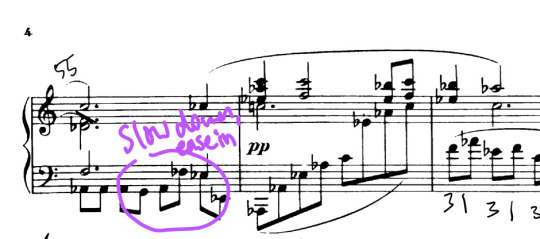
Dream in Exile I did a great job capturing the gloomy and depressive mood in Dream in Exile, though some parts weren’t supposed to be that gloomy, haha. The tricky rhythms were mostly accurate, and I made sure to take note of them for further refinement. Unfortunately, we ran out of class time, so we’ll continue working on it next lesson.
Conclusion
Overall, today’s session was productive in refining the finer details and understanding the nuances of each piece. From controlling dynamics in Étude No. 2 to shaping phrases and rhythm in Nocturne No. 1, and capturing the mood of Dream in Exile, each piece presented unique challenges and growth opportunities. I’m slowly grasping the deeper mood and emotion of each piece, and I’m starting to see the distinct characters that define them. I’ve also realized that getting into and changing the mood for each work is crucial—and a bit difficult. It feels like I’m a face-masking, ever-changing performer, constantly adjusting my approach to fit the emotional landscape of each piece. There’s still work to be done, but I’m excited to continue refining these works and seeing how these small adjustments will shape my performance.
0 notes
Text
Week 8: A Bird's-Eye View of Goyescas and Hypnotic Etude
Today, we picked up right where we left off in our last lesson with Goyescas, refining the details and deepening our interpretation. We also revisited Philip Glass’s Etude, going through it once more to solidify our approach and explore new nuances in its hypnotic patterns. Goyesca: Bar 35: Speed up notes highlighted, and wait a little before playing 'E' in RH Bar 38-39: Slow down a little, not too much such that it sounds like an ending

Bar 40: Do not delay entry of semiquavers too much
Bar 46-54: Needs more rubato to make it interesting as I am slowing down very predictably.
Bar 46: Slow down last 2 quavers a little before entering the next bar
Bar 49: Cresc. into bar 50

Bar 50: LH to slows down throughout the bar
Bar 55-56: Do not delay moving to bar 56, do not slow down too much here yet
Bar 57-58: Do not delay moving to bar 58, slower version of bar 55-56
Bar 64-67: Needs to have more direction, create my own phrasing even if not marked in score, to make it easier for listeners to interpret

Bar 68-end: Too machine-like, needs to feel free and light like a bird.
Bar 68-70: Delay entrance of 2nd group of notes, gradually increase speed through the bars
Bar 70-71: keep trilling and seamlessly blend into 71
Bar 71: Start slow and soft then increase speed and loudness
Bar 74: LH notes to speed up a little to make it sound less draggy
Bar 75 & 78: Change pedal clearly for every 8 notes
Bar 82: Pedal only first 3 notes of each phrase to produce a light sound

Conclusion
The main challenge I faced today was making the remaining sections of Goyescas sound more fluid and natural. I realized that I’m sometimes unaware of how I might be unintentionally breaking up phrases, which disrupts the overall flow. Additionally, I struggled to capture the bird-like freedom in the cadenza, as it still felt a bit rigid and lacking in spontaneity. We didn’t have time to dive into the details of the etude today, but it was still good to run through it. I’ll have to take a closer look at it next time!
0 notes
Text
Week 7: Finally Hitting the Goyesca-Spot
Today marks a significant milestone in my musical journey—I've officially completequd the full cycle of playing through my entire repertoire and have now come full circle, returning to where I started: Goyesca No. 4. This full-circle moment isn’t just about repeating the same old notes—it’s about seeing how far I’ve come. The pieces feels different now, and it’s exciting to notice new details and bring a bit more depth to it. I’m looking forward to refining it and seeing how much more I can bring out of it. The main challenge in my playing today was my unnatural rubatos—which, honestly, seems to be a recurring issue in all my pieces. Mr. Bialak suggested that I record myself and listen back, so I can better assess how to improve my rubatos and make them feel more natural. Bar 1: Do not abruptly slow down ay 3rd beat after doing a super fast turn. Rubato would seem very disconnected. Bar 3: Slow down a little from beat 3 to 4 Bar 4: Slow down even more Bar 8: Wait a little before playing semiquavers in RH to create slowing down effect after increasing speed in the previous bar Bar 9: Start first 2 notes slow before speeding up to make it more emotive Bar 10: Do not rush triplets Bar 15: Soften RH but Cresc. in LH

Bar 17: RH demisemiquaver can be played slower, no need to be a tempo Bar 18: Ornaments to be played quickly in BH Bar 20-21: Cresc. and lead up to first chord of bar 21, do not deflate too quickly Bar 21: Do not play hemidemisemiquaver in a relaxed speed, LH leap from 'A' to 'C&F' quickly Bar 23: Speed up first 2 notes of semiquaver and slow down at the next 2 Bar 24-26: Create an even more intense cresc. than before (Bars 20-23) Bar 25: Only slow down last 2 semiquavers a little Bar 27: Gradually get slower with every beat Bar 28: Keep appoggiaturas light and quick but steadily slow down the main melody

Bar 33: Do note rush triplets Bar 35: Make sure to sound G natural in BH Bar 36: Speed up LH over first 4 semiquavers then slow down over the rest of the bar, take note to play A# in RH

Conclusion
Grasping the timing of rubato is undeniably challenging. It feels like trying to master the flow of time itself, balancing flexibility and precision in a way that brings out the emotional depth of the music without losing its structure. It’s about finding that perfect moment when the music breathes and sways, yet still holds together. With each practice, I’m slowly learning to trust the ebb and flow, but it’s clear that true mastery will take time and careful listening. The more unique and challenging aspect of this piece lies in the appoggiaturas and turns scattered throughout, which must be seamlessly coupled with the rubato. These ornaments require careful attention to timing and expression, as they need to flow naturally within the broader pulse of the music. Balancing the delicate execution of these ornamentations with the flexibility of rubato adds an extra layer of difficulty, demanding both technical precision and emotional sensitivity. It’s a fine line between shaping the notes expressively and maintaining control over the overall phrasing.
0 notes
Text
Week 6: Debussy Gave Me the Ick
After last week’s breakdown in class, I have to admit—I haven’t been feeling very motivated to work on Suite Bergamasque. In fact, I’ve been avoiding it entirely. Every time I see the sheet music, I feel like it’s mocking me for not getting it right. Right now, just thinking about Suite Bergamasque makes me want to do anything else—wash dishes, reorganize my bookshelf, stare at the ceiling. It’s not that I suddenly hate the piece, but after last week, it feels heavy, like a reminder of everything that went wrong. Playing it doesn’t excite me; it just brings back the frustration. So, for now, I’m giving myself permission to not play it. Maybe I’ll come back to it when it feels less like a chore and more like music again... until it’s time for my lesson with Mr. Bialak (*screams*) Today, we picked up from where we left off with Menuet, and I also played through Clair De Lune.
Menuet
During the lesson, we focused on the touch for the staccatos in Menuet. Mr. Bialak emphasized the importance of making each staccato note sharp and precise, while still maintaining a light, almost airy quality to avoid sounding too harsh. It was all about finding the perfect balance between clarity and elegance. Bar 15: Slight cresc. before dim. in following bars Bar 18-21: Keep staccatos light, imagine plucking a guitar string

Bar 32: Check RH notes Bar 35-37: Keep RH soft Bar 46-48: Keep fingers close to keyboard when playing staccato Bar 86: End the phrase soft and gently Bar 92: "tres soutenu" pull back, do note speed up instead Clair De Lune Clair de Lune actually went better this time, and according to Mr. Bialak, it even had its "moments." It felt more natural to play, and the interpretation came to me with less effort than before. The phrasing and expression seemed to flow more easily, as if I wasn’t overthinking every note. There were still places that needed refinement, but overall, I could feel myself connecting with the piece in a way that wasn’t as forced. Although my rubato can sometimes sound like a car that won’t stop braking —just like a bad driver. There were moments where my tempo shifts were a little too abrupt. It’s something I need to smooth out, finding that balance between expressive freedom and keeping the music flowing naturally. Bar 5-6, 7-8: See them as 2 bar rubatos (i was seeing each group of dotted crotchet previously) Bar 12: Delay entry for RH 'D'

Bar 14: Play it slower than bar 13 Bar 19-20> 21-22> 23-24: Increase intensity and speed every 2 bars Bar 27 and other similar texture throughout the piece: Make sure pedal is changing cleanly, do not hold non-melodic notes in RH, keep semiquavers quiet Bar 33: Voice RH melodic notes Bar 37: Plan LH fingering again Bar 41-42: Climax of the piece, make sure to play it loud and fast Bar 51-58: Do not gradually slow down, it is not the near the ending of the piece yet Bar 64: Push tempo a little Bar 65-68: Do not slow down too much
Conclusion
This week’s lesson felt like a mix of small wins and ongoing struggles. Clair de Lune showed signs of improvement, and for the first time in a while, the interpretation felt more natural to me. Menuet brought some technical challenges, especially with refining the staccatos and appoggiaturas, but at least it’s a work in progress. Emotionally, I’m still feeling a little off. Last week’s frustration hasn’t completely faded, and part of me is still hesitant to fully dive back into practice. I know that setbacks are part of the process, but that doesn’t make them any easier to push through. At the same time, moments of progress—like when Clair de Lune actually felt good to play—remind me why I do this in the first place. Maybe motivation doesn’t come all at once; maybe it returns in small pieces, through tiny victories that slowly rebuild confidence. It’s not a perfect comeback, but for now, I’ll take it.
0 notes
Text
Week 5: When Every Wrong Note Feels Personal
Today’s lesson was especially tough. Mr. Bialak and I worked intensively on the Prélude and Menuet from Suite Bergamasque, tackling difficult passages that pushed my technique and patience to the limit. After Mr. Bialak corrected my playing in the Prélude, I realized I had been neglecting my touch and control, especially at the ends of phrases. I had been so focused on getting through the notes that I wasn’t truly shaping the sound with care. Below are some changes discussed:

Bar 3: Do not start first beat too harshly

Bar 11-12: Decrescendo needs to be heard, speed up a little when playing Crescendo

Bar 18: Do not slow down too much till it sounds like an ending to the piece
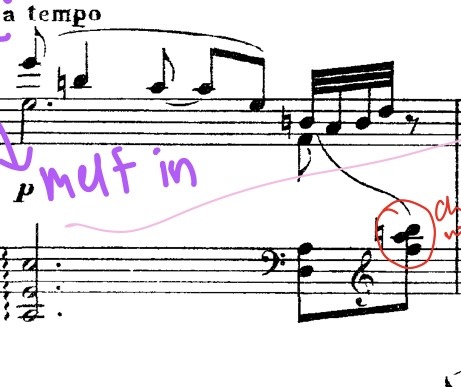
Bar 20: Left hand to cross over quickly and played immediately after RH

Bar 26-27: Make sure to play notes highlighted in yellow together at once, cross LH over quickly too

Bar 56-59: Decide on one line to bring out (purple or red)
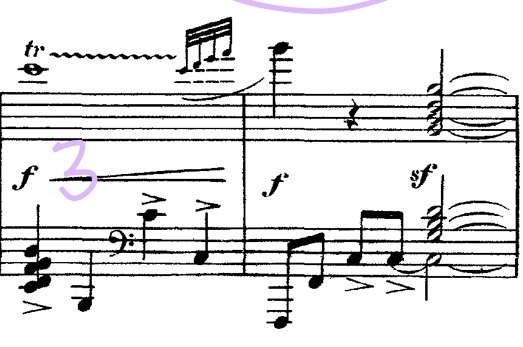
Bar 50: Time RH thrill and refrain from playing demisemiquavers too early
Menuet:
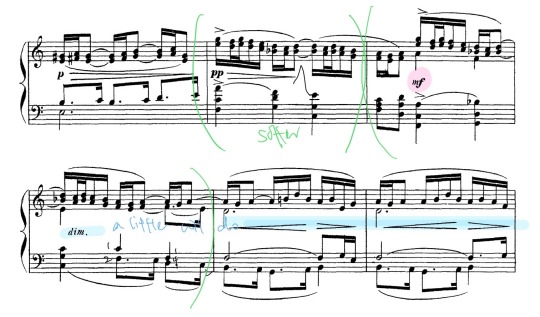
Bar 1: Slur RH notes in beat 3

Bar 5: Play a little softer so that it contrasts with bar 6-7

Bar 16-17: Keep non-melody notes soft
Bar 18: Pedal LH "A" a little
Conclusion
Overall, I found it challenging to understand and execute rubato in the Prelude. Balancing flexibility with control while maintaining the musical flow was difficult, especially in sections requiring subtle tempo shifts. I struggled to determine how much freedom to take without disrupting the overall structure and phrasing.
Lately, I’ve been struggling with Debussy’s Menuet too. Capturing its delicate, airy character has been challenging, and no matter how much I refine my touch, I can’t seem to achieve the effortless lightness it demands.
One of the biggest hurdles has been the appoggiaturas. Some feel too stretchy for my hands, making them difficult to execute smoothly. Others disrupt the flow of the piece when I try to integrate them seamlessly. It’s frustrating—on paper, they seem like fleeting ornaments, yet in practice, they require a level of finesse that feels just out of reach.
0 notes
Text
Week 4: One Felt Natural, One Felt Like a Memory Test
For today’s PS, Mr. Bialak and I continued working on Dream in Exile from where we left off. I also presented the Prélude from Suite Bergamasque. I feel like I’m starting to capture the dreamy and exotic character of Dream in Exile. I needed to shape my musicality more effectively, breaking up bars 45–49 into two phrases for the ear rather than following the long phrase as written in the score. This gives the music a clearer sense of direction instead of letting it meander. A singing quality also needed more attention to enhance the phrasing and expressiveness.
Other areas worked on:
Bar 60: Check rhythm of crotchet triplet
Bars 60-64: Double check RH notes
Bars 66-67: Voice melodic line more clearly
Bars 81-86: Keep LH soft, gentle and elusive
Bar 92: Check rhythm of LH semiquaver triplets
Bars 100-101: Make sure LH notes can be clearly heard
Bars 113-118: Reorganise on how to shape my phrases
Bar 118: Learning to grasp “dying away” both aurally and visually
Bar 120: Do not play RH semiquaver triplet to early since it is “dying away”
While Dream in Exile was generally easier to correct, the Prélude from Suite Bergamasque didn’t go as smoothly. I attempted to play it from memory, but this only exacerbated my performance. My memory wasn’t secure, and I had many stumbles, which disrupted the flow. Without the security of the score, I found myself losing focus on the finer details and struggling with transitions, which affected the overall flow of the piece.
Memorisation has been a challenge for me since Year 1. Despite many attempts, I’ve continued to struggle, and performance nerves only make it worse—causing my memory to crumble easily. I feel nervous whenever I have to present a piece, even if it’s just in front of one person. I tend to lose focus and overthink how bad my playing sounds, making every mistake feel magnified in my ears. No matter how prepared I feel—or how much I’ve actually prepared—it always turns out worse than I anticipated. Even when I keep my hopes low and try to stay positive, the outcome still falls short of my expectations.
I’m not sure how to fix this, and it’s frustrating because I feel like I’ve tried everything—practicing more, mentally preparing myself, and keeping my expectations realistic—yet the problem persists. It’s disheartening to put in so much effort only to feel like I’m not improving where it matters most. I worry that no matter how much I practice, nerves will always get the better of me, making my playing sound worse than it actually is. It makes me question whether I’ll ever feel truly confident when performing, or if this will always be a struggle.
Nonetheless, I think a step forward was me playing from memory in PS, even if it might not seem like a big achievement in other people’s eyes. I’ve always felt extremely shy when presenting my playing—it almost feels too raw and exposed, as if I’m laying a part of myself bare for judgment. The vulnerability of performing, especially from memory, makes every mistake feel magnified, adding to the pressure. Even so, I know that pushing myself to do it is necessary for growth.
Suite Bergamasque seems to be the weakest piece in my repertoire, as its style and interpretation don’t come naturally to me. Unlike Dream in Exile, which felt more intuitive, I find myself struggling to shape the phrases and capture the character of the piece. The lightness, fluidity, and elegance that define Debussy’s style don’t emerge effortlessly in my playing, making it feel less convincing. This disconnect makes me question whether I truly understand the piece on a deeper level or if I’m simply not attuned to its stylistic nuances yet.
We didn’t have much time to work in detail and only managed to go through the first page. Mr Bialak gave lots of feedback and it seems like I was doing something wrong in almost every bar—whether it was phrasing issues or stumbling over notes. On top of that, I was also affected by my own poor playing from memory the first time round, which made me even more unsure of myself.
Conclusion
Overall, this session highlighted some of the challenges I’m still facing in my playing, especially when it comes to memorisation and interpretation. While I’ve made progress with Dream in Exile, it’s clear that Suite Bergamasque needs more attention to bring out its true character and refine my phrasing. My nerves and shyness around presenting pieces continue to be a struggle, and playing from memory, though a step forward, only amplified my insecurities. Despite these setbacks, I’m determined to keep pushing through. Each session, no matter how difficult, brings me closer to understanding and overcoming these obstacles, and I know that with patience and consistent effort, I’ll get closer to the musicality I’m striving for.
0 notes
Text
Week 3: Couples Therapy for Hands, Helping RH & LH Work as a Team
Today, I played Nocturne No. 1 and Dream in Exile in class again after a long break. I presented Nocturne No. 1 from memory, having worked on it over the holidays.
Memorisation has always been a challenge for me since my first year, and performing from memory in front of others often makes me nervous. Even when I feel secure in my practice, the pressure of presenting can sometimes cause hesitation. However, today’s performance was a step forward—I was able to finish the piece luckily, although with some memory lapses in the last section. Some phrasing of the melody was also overlooked because I was more concentrated on the memory part. Apart from working at my own pace to build confidence and trust in my memory while getting accustomed to playing for an audience, I also needed to make some adjustments to the balance between my right and left hand.
Nocturne No.1 Bar 1: Emphasis should be out on RH minim 'E' Bar 4: Release 'D' when playing 'C' and change pedal to avoid dissonance Bar 8: RH 'B' and 'G' needs to be played slightly louder so that it lasts and does not get buried under the next few quaver notes Bar 12: LH 'D' needs to be heard Bar 13: RH 'E' needs to be played louder so that it lasts for its value Bar 25 & 27: Decrescendo for notes after the end of the phrase Bar 36: LH to be kept soft, RH has to compensate more to be heard since it is in the high treble range Bar 39: Change RH notes clearly from 'D' to 'C' Bar 71-80: Decide on which line to bring out Bar 81-83: keep LH quavers soft, in the background while decrescendo-ing Overall, My right-hand touch needs to be even and singing, ensuring clarity in the melodic line. I also need to be mindful of maintaining balance so that my left hand doesn’t overpower the right while keeping the right hand from losing momentum. Dream in exile Dream in Exile suffers from the same issues as the previous piece—losing momentum too early and needing better balance between both hands. Additionally, some passages feel a little too unemotive and could benefit from more expressive shaping. The character of this piece needs to be handled carefully due to its slightly unconventional tonalities, which can easily make the playing sound aimless if not shaped with intention and direction. Mr. Bialak highlighted that incorporating timely rubato and dynamic contrasts will enhance the theatricality of the piece, making it more engaging and expressive. Bar 6-7: Take some time before settling on the chord on bar 7, while bring out F# in RH the most Bar 12: Remember to shape and play expressively for RH Bar 13-14: Slow down and take some time before entering bar 14 Bar 18: Slow down, time allargando for triplet accurately so it does not sound like a rhythm mistake Bar 22-23: Wait a little before entering bar 23 Bar 23: Delay entry of LH Bar 35: Start slow so that the new section is highlighted to the audience What I find challenging is grasping the elasticity of rubato while maintaining sensitivity in shaping and dramatizing different sections of the piece. It requires careful judgment to ensure that the expressiveness feels natural rather than exaggerated.
Conclusion
This week’s practice and class performance highlighted both progress and areas for refinement in my playing. While I have made strides in memorization, I still need to build greater confidence in performing from memory without letting nerves affect phrasing and expression. The challenge of balancing my hands remains a key focus, as achieving clarity in the right-hand melody while maintaining control in the left requires ongoing adjustments. Additionally, Dream in Exile reinforced the importance of shaping musical lines with intention, using rubato and dynamics effectively to avoid sounding aimless. Moving forward, I aim to develop a more instinctive sense of rubato and dynamic contrast while strengthening my overall control and expressiveness in both pieces.
0 notes
Text
Week 2: A Minimalist Vision and Goyescas Precision
Today, I presented Philip Glass’s Etude No. 2, followed by more work on Goyesca No.4. This was my first time working on a minimalist piece, making it an exciting new challenge. The question I often find myself pondering when working on a minimalist piece is: how can I make it truly interesting?
I’ve decided to experiment with different colors and dynamics to add depth and variation, making the minimalist piece more engaging. Unfortunately, trying to maintain the repetitive patterns in the left hand has proven to be a bit tricky, as it needs to be very even while still keeping the performance dynamic.

The feedback I received from Bialak was that sometimes my attention tends to wander, which can affect the consistency of my performance, and my pedaling blurs as a result.

Section 5: I imagine each highlighted box fading out, much like the reverberation of a gong after it’s struck. This would create a smooth transition, adding a dynamic texture to the piece.

Section 8: Some reorganization of the notes between the right and left hands was needed. I’ll need to continue working on this, as I find it challenging to play octaves quickly in my left hand, especially when combined with occasional leaps in the right hand. As for Goyesca No.4, We focused on refining my rubato, as it often feels somewhat uncontrolled. I have a tendency to either speed up too quickly or slow down progressively over time. Understanding and conveying the Spanish flavor in the piece was quite challenging. Capturing the unique rhythmic vitality, rich harmonies, and expressive nuances required careful attention to stylistic details and an understanding of the cultural essence behind the music. To deepen my interpretation, I was tasked with listening to more Spanish music, which helped me better grasp the stylistic traits and bring out the piece’s authentic character.
0 notes
Text
Back to School, Week 1: The Calm Before the Homework Storm
Just wrapped up my first personal study session after the semester break. I spent my entire semester break rushing to learn two new pieces—Granados’s Goyesca No. 4 and Glass’s Etude No. 2, which rounds up my 40 minute program.
My final program for the semester is shaping up to be:
Poulenc – Nocturne No. 1
Debussy – Prelude, Minuet, and Clair de Lune (from Suite Bergamasque
Bax – Dream in Exile
Glass – Etude No. 2
Granados – Goyesca No. 4 Nearly crashed out trying to get them under my fingers. God bless, though—my teacher thought my Goyesca sounded decent (somehow). Goyesca No. 4 is such an interesting piece. Written by Spanish composer Enrique Granados, it features some beautiful Spanish music elements—rich harmonies, rhythmic flair, and that unmistakable charm. The piece is filled with beautiful trills and appoggiaturas, which I’ve been struggling to execute smoothly. During my lesson with Mr. Bialak, we laughed about how Spain’s national instrument is the guitar—and how, at times, Granados’s writing doesn’t exactly translate easily to the piano... We also took some time to discuss and plan the phrasing and rubato. I tried to play it the way I heard it in Alicia de Larrocha's recording—though that didn’t quite work out for me, haha. Mr. Bialak gently pointed out that while it might work beautifully for her, it doesn’t mean it will work for everyone, so I shouldn’t simply copy but find my own interpretation instead.

Bar 1: Discussed on how to fit the turn stylistically into the piece. I was playing it too fast.
recording- before
recording- after
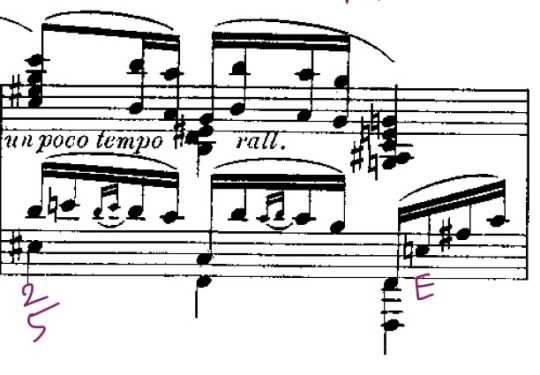
Bar 28: Appoggiatura in LH needs to be light and quick so that emphasis is on the main notes.
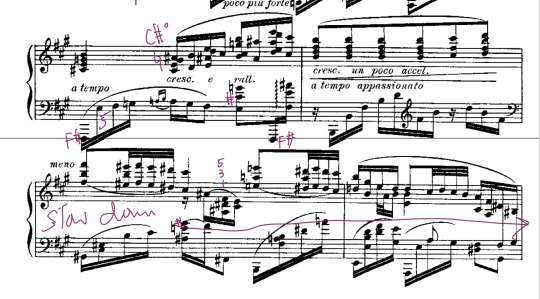
Bar 36-39: Planned on the speed of slowing down. I initially planned to follow Alicia's recording for the pacing of the slowdown. However, this approach didn’t align well with the style I had established at the beginning of my performance. Additionally, I found it challenging to replicate Alicia’s interpretation effectively.
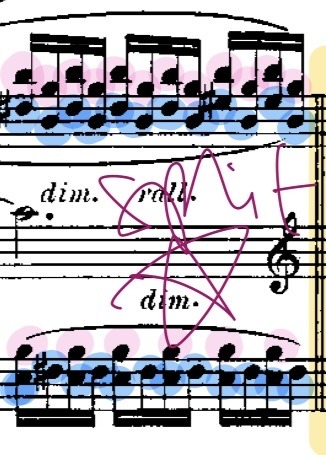
Bar 45: I discovered that reorganizing the distribution of notes between the hands made the piece easier to play, rather than strictly adhering to the score. The sections highlighted in pink indicate notes for the right hand, while those in blue are for the left hand.
Conclusion
Wrapping up the session, I’m feeling both challenged and inspired. This piece is pushing me in so many ways, from technical execution to crafting a personal interpretation that feels authentic to me. There’s a long road ahead to bring everything together, but moments like these remind me why I love the process. One practice session at a time—I’m ready to dive back in and keep exploring
0 notes